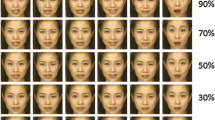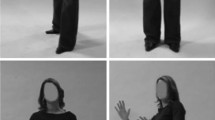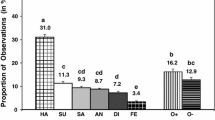Abstract
Children who experienced autism, mental retardation, and language disorders; and, children in a clinical control group were shown photographs of human female, orangutan, and canine (boxer) faces expressing happiness, sadness, anger, surprise and a neutral expression. For each species of faces, children were asked to identify the happy, sad, angry, or surprised expressions. In Experiment 1, error patterns suggested that children who experienced autism were attending to features of the lower face when making judgements about emotional expressions. Experiment 2 supported this impression. When recognizing facial emotion, children without autism performed better when viewing the full face, compared to the upper and lower face alone. Children with autism performed no better when viewing the full face than they did when viewing partial faces; and, performed no better than chance when viewing the upper face alone. The results are discussed with respect to differences in the manner that children with and without autism process social information communicated by the face.
Similar content being viewed by others
REFERENCES
American Psychiatric Association. (1994). The diagnostic and statistical manual of mental disorders, IV. Washington, DC: Author.
Baron-Cohen, S. (1991). Do people with autism understand what causes emotion? Child Development, 62 ,385–395.
Baron-Cohen, S., Campbell, R., Karmiloff-Smith, A., Grant, J., & Walker, J. (1995). Are children with autism blind to the mentalistic significance of the eyes? British Journal of Developmental Psychology, 13 ,379–398.
Baron-Cohen, S., Spitz, A., & Cross, P. (1993). Do children with autism recognize surprise? Cognition and Emotion, 7 ,507–513.
Baron-Cohen, S., Wheelwright, S., & Jolliffe, T. (1997). Is there a "language of the eyes?" Evidence from normal adults and adults with autism or Aspergers syndrome. Visual Cognition, 4 ,311–331.
Bormann-Kischkel, C., Vilsmeier, M., & Baude, B. (1995). The development of emotional concepts in autism. Journal of Child Psychology and Psychiatry and Allied Disciplines, 36 ,1243–1259.
Boucher, J., & Lewis, V. (1992). Unfamiliar face recognition in relatively able autistic children. Journal of Child Psychology and Psychiatry and Allied Disciplines, 33 ,843–859.
Boucher, J., Lewis, V., & Collis, G. (1998). Familiar face and voice matching and recognition in children with autism. Journal of Child Psychology and Psychiatry and Allied Disciplines, 39 ,171–181.
Braverman, M., Fein, D., Lucci, D., & Waterhouse, L. (1989). Affect comprehension in children with pervasive developmental disorders. Journal of Autism and Developmental Disorders, 19 ,301–316.
Buck, R., & Duffy, R. J. (1980). Nonverbal communication of affect in brain damaged patients. Cortex, 16 ,351–362.
Camras, L. A., Dunn, J., Izard, C. E., Lazarus, R., Panksepp, J., Rothbart, M. K., et al. (1994). What develops in emotional development? In P. Ekman & R. J. Davidson (Eds.), The nature of emotions: Fundamental questions(pp. 345-375). New York: Oxford University Press.
Capps, L., & Sigman, M. (1996). Autistic aloneness. In R. D. Kavanaugh, B. Zimmerberg, & S. Fein (Eds.), Emotion: Interdisciplinary perspectives(pp. 237-296). Hillsdale, NJ: Erlbaum.
Capps, L., Yirmiya, N., & Sigman, M. (1992). Understanding of simple and complex emotions in non-retarded children with autism. Journal of Child Psychology and Psychiatry and Allied Disciplines, 33 ,1169–1182.
Celani, G., Battacchi, M. W., & Arcidiacono, L. (1999). The understanding of the emotional meaning of facial expressions in people with autism. Journal of Autism and Developmental Disorders, 29 ,57–66.
Chevalier-Skolnikoff, S. (1973). Facial expression of emotion in nonhuman primates. In P. Ekman (Ed.), Darwin and facial expression: A century of research in review(pp. 11-89). New York, NY: Academic, Press.
Cunningham, J., & Odom, R. (1986). Differential salience of facial features in children's perception of affective expression. Child Development, 57 ,136–142.
de Waal, F. (1989). Peacemaking among primates. Cambridge, MA: Harvard University Press.
Dodge, K. (1993). Social-cognitive mechanisms in the development of conduct disorder and depression. Annual Review of Psychology, 44 ,559–584.
Ekman, P. (1985). Telling lies: Clues to deceit in the marketplace, politics and marriage. New York, NY: Norton.
Ekman, P. (1989). The argument and evidence about universals in facial expressions of emotions. In H. Wagner & A. Manstead (Eds.), Handbook of social psychophysiology(pp. 143-164). Chichester, England: Wiley.
Elfenbein, H. A., & Ambady, N. (2002). On the universality and cultural specificity of emotion recognition: A meta-analysis. Psychological Bulletin, 128 ,203–235.
Feldman, R. S., McGee, G. C., Mann, L., & Stain, P. (1993). Nonverbal affective decoding ability in children with autism and in typical preschoolers. Journal of Early Intervention, 17 ,341–350.
Frijda, N. H. (1986). The emotions. New York: Cambridge University Press.
Frith, U., & Happé, F. (1994). Autism: Beyond "Theory of Mind." Cognition, 50 ,115–132.
Gross, T. F. (2002). Perception of human and non-human facial age by developmentally disabled children. Journal of Autism and Developmental Disorders, 32 ,169–179.
Gross, A. L., & Ballif, B. (1991). Children's understanding of emotions from facial expressions and situations: A review. Developmental Review, 11 ,368–398.
Hall, R. L., & Sharp, H. S. (1978). Wolf and man: Evolution in parallel. New York, NY: Academic Press.
Hobson, R. P. (1993). Understanding persons: The role of affect. In S. Baron-Cohen, H. Tager-Flusberg, & D. J. Cohen (Eds.), Understanding other minds: Perspectives from autism(pp. 204-224). Oxford, UK: Oxford University Press.
Hobson, R. P., & Ouston, J. (1989). Naming emotion in faces and voices: Abilities and disabilities in autism and mental retardation. British Journal of Developmental Psychology, 7 ,237–250.
Hosie, J. A., Gray, C. D., Russell, P. A., Scott, C., & Hunter, N. (1998). The matching of facial expressions by deaf and hearing children and their production and comprehension of emotion labels. Motivation and Emotion, 22 ,293–313.
Izard, C. E., Fantauzzo, C. A., Castle, J. M., Haynes, O. M., Rayias, M. F., & Putnam, P. H. (1995). The ontogeny and significance of infants' facial expressions in the first 9 months of life. Developmental Psychology, 31 ,997–1013.
Jenkins, J. M., & Ball, S. (2000). Distinguishing between negative emotions: Children's understanding of the social-regulatory aspects of emotion. Cognition and Emotion, 14 ,261–282.
Klin, A., Jones, W., Schultz, R., Volkmar, F., & Cohen, D. (2002). Visual fixation patterns during viewing of naturalistic social situations as predictors of social competence in individuals with autism. Archives of General Psychiatry, 59 ,809–816.
Langdell, T. (1978). Recogniton of faces: An approach to the study of autism. Journal of Child Psychology and Psychiatry and Allied Disciplines, 19 ,255–268.
Linnankoski, I., Laakso, M., Aulanko, R., & Leinonen, L. (1994). Recogniton of emotions in macaque vocalizations by children and adults.Language and Communication, 14 ,183–192.
Manstead, A. S. R. (1993). Children's representation of emotion. In C. Pratt & A. F. Garton (Eds.), Systems of representation in children: Development and uses(pp. 185-210). New York: Wiley.
McAlpine, C., Kendall, K., & Singh, N. N. (1991). Recognition of facial expression of emotion by persons with mental retardation. American Journal of Mental Retardation, 96 ,29–36.
McAlpine, C., Singh, N. N., Kendall, K., & Ellis, C. R. (1992). Recognition of facial expressions of emotion by persons with mental retardation: A matched comparison study. Behavior Modification Special Issue: Current Research on Social Behavior, 16 ,543–558.
Ozonoff, S., Pennington, B. F., & Rogers, S. J. (1990). Are there emotional perception deficits in young autistic children? Journal of Child Psychology and Psychiatry and Allied Disciplines, 31 ,343–361.
Pascalis, O., Demont, E., de Haan, M., & Campbell, R. (2001). Recognition of faces of different species: A developmental study between 5 and 8 years of age. Infant and Child Development, 10 ,39–45.
Prodan, C. I., Orbelo, D. M., Testa, J. A., & Ross, E. D. (2001). Hemispheric differences in recognizing upper and lower facial displays of emotion. Neuropsychiatry, Neuropsychology, and Behavioral Neurology, 14 ,206–212.
Reichenbach, L., & Masters, J. (1983). Children's use of expressive and contextual cues in judgements of emotion. Child Development, 54, 993–1004.
Rinehart, N. J., Bradshaw, J. L., Moss, S. A., Brereton, A. V., & Tonge, B. L. (2000). Atypical interference of local detail on global processing in high-functioning autism and Asperger's disorder. Journal of Child Psychology and Psychiatry and Allied Disciplines, 41 ,769–778.
Roid, G. H., & Miller, L. J. (1997). Leiter International Performance Scale-Revised. Wood Dale, IL: Stoelting.
Rojahn, J., Rabold, D. E., & Schneider, F. (1995). Emotion specificity in mental retardation. American Journal of Mental Retardation, 99 ,477–486.
Ross, E. D., Homan, R.W., & Buck, R. (1994). Differential hemispheric lateralization of primary and social emotions. Neuropsychiatry, Neuropsychology, and Behavioral Neurology, 7 ,1–19.
Sabbagh, M. A. (1999). Communicative intentions and language: Evidence from right-hemisphere damage and autism. Brain and Language, 70 ,26–69.
Schopler, E., Reichler, R. J., & Renner, B. R. (1988). The Childhood Autism Rating Scale. Los Angles, CA: Western Psychological Services.
Scott, J. P., & Fuller, J. L. (1965). Genetics and the social behavior of canines.Chicago: The University of Chicago Press.
Sigman, M. D., Kasari, C., Kwon, J., & Yirmiya, N. (1992). Responses to the negative emotions of others by autistic, mentally retarded, and normal children. Child Development, 63 ,796–807.
Sigman, M. D., & Mundy, P. (1989). Social attachments in autistic children. Journal of the American Academy of Child and Adolescent Psychiatry, 28 ,74–81.
Smith, C. A., & Scott, H. H. (1998). A componential approach to the meaning of facial expression. In J. A. Russell & J. M. Fernandez-Dols (Eds.), The psychology of facial emotion(pp. 229-320). Cambridge: Cambridge University Press.
Sparrow, S. S., Balla, D. A., & Cicchetti, D.V. (1984). Vineland Adaptive Behavior Scales. Circle Pines, MN: American Guidance Service.
Thorndike, R. L., Hagen, E. P., & Sattler, J. M. (1986). Stanford-Binet Intelligence Scale, 4th ed. Chicago, IL: The Riverside.
Travis, L. L., & Sigman, M. (1998). Social deficits and interpersonal relationships in autism. Mental Retardation and Developmental Disabilities, 4 ,65–72.
Walden, T. A., & Field, T. M. (1982). Discrimination of facial expressions by preschool children. Child Development, 53 ,1312–1319.
Wechsler, D. (1991). Wechsler Intelligence Scale for Children-3rd ed. New York, NY: The Psychological Corporation.
Weeks, S. J., & Hobson, R. P. (1987). The salience of facial expression for autistic children. Journal of Child Psychology and Psychiatry and Allied Disciplines, 28 ,137–151.
Yirmiya, N., Sigman, M. D., Kasari, C., & Mundy, P. (1992). Empathy and cognition in high functioning children with autism. Child Development, 63 ,150–160.
Author information
Authors and Affiliations
Rights and permissions
About this article
Cite this article
Gross, T.F. The Perception of Four Basic Emotions in Human and Nonhuman Faces by Children With Autism and Other Developmental Disabilities. J Abnorm Child Psychol 32, 469–480 (2004). https://doi.org/10.1023/B:JACP.0000037777.17698.01
Issue Date:
DOI: https://doi.org/10.1023/B:JACP.0000037777.17698.01




